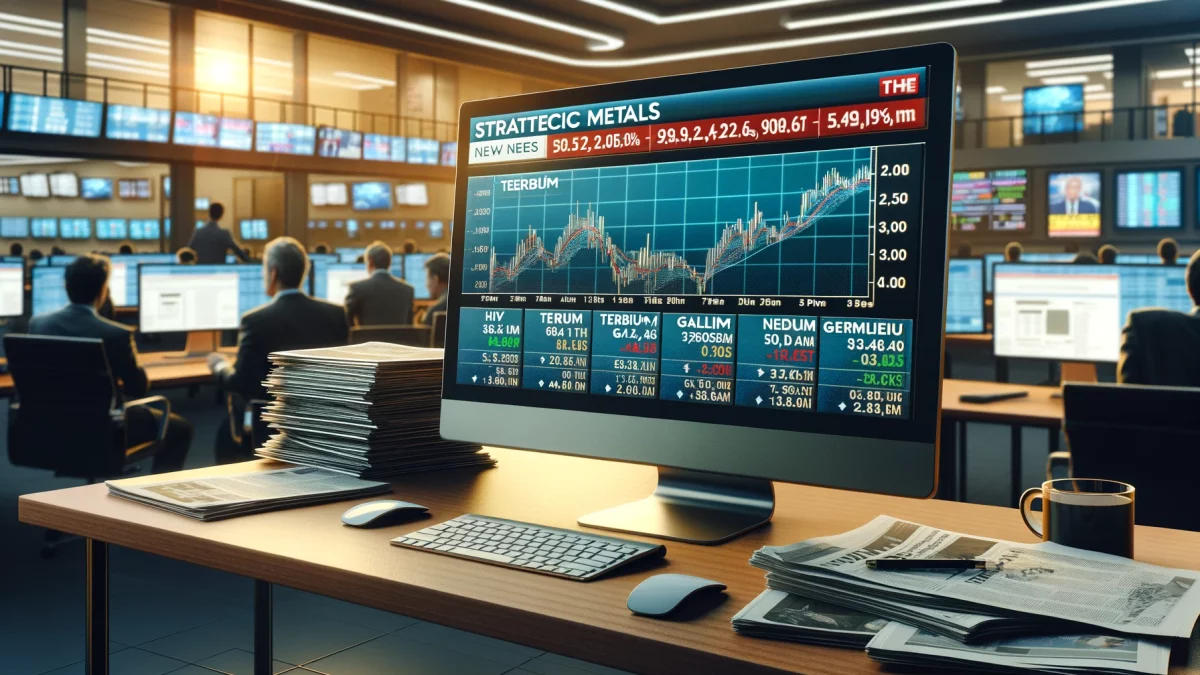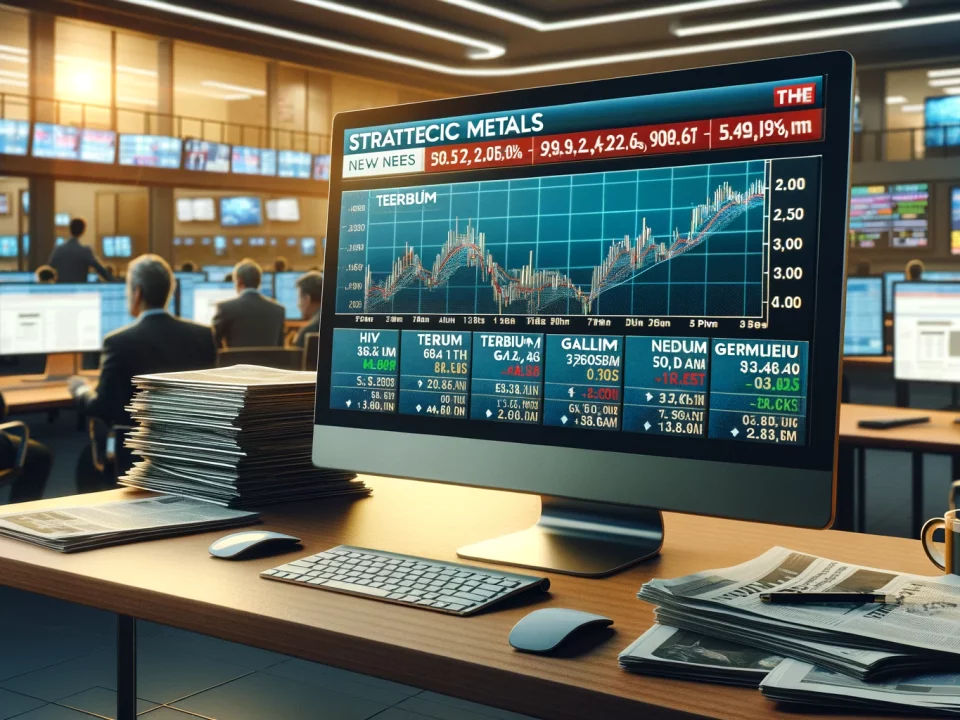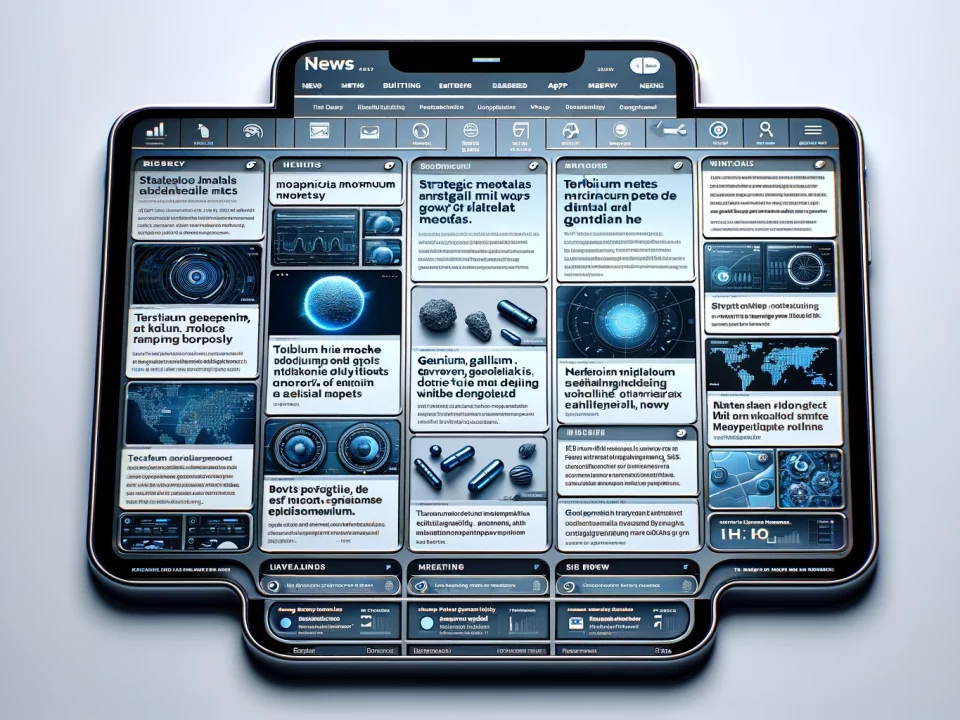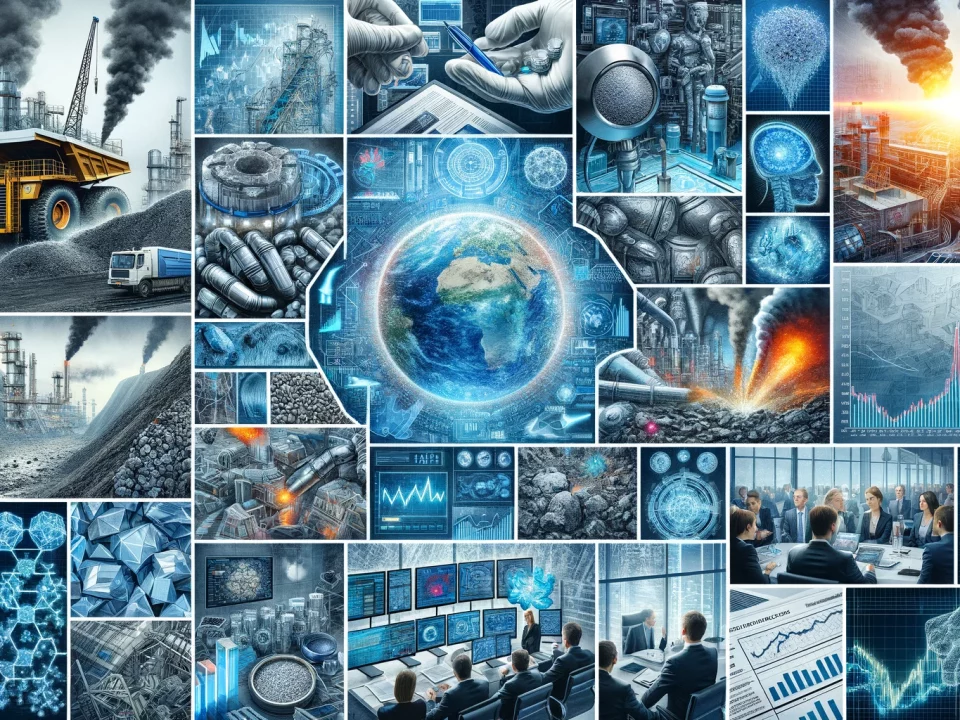
Weekly News Review June 30 – July 6 2025
July 6, 2025
Weekly News Review July 14 – July 20 2025
July 20, 2025The EU is unveiling a new strategy to secure critical raw material reserves. In Australia, Arafura is seeking German support for its rare earth project, while India is expanding its production of NdFeB magnets. Meanwhile, in the U.S., MP Materials has entered a strategic partnership with the Department of Defense to strengthen domestic rare earth and magnet supply chains.
All this and more and our quarterly market report from our industry partner.
WILL RARE EARTHS UNLOCK THE BREAKTHROUGH IN ENERGY STORAGE?
Renewable energy is widely regarded as a central pillar in the fight against global climate change. However, most forms—such as wind and solar power—depend on weather conditions and daylight, meaning the electricity they generate is not always available when needed. To provide power on demand, the primary storage solutions currently used are pumped-storage hydroelectricity and battery systems. Additionally, supercapacitors are often used to complement batteries.
These devices store energy in an electric field and, unlike batteries, can charge and discharge extremely quickly. This makes supercapacitors ideal for smoothing out power peaks or compensating for short-term fluctuations in volatile renewable energy systems. They are also used in applications that require rapid charging and discharging, such as smartphones and electric vehicles.
Supercapacitors are additionally known for their long service life and low maintenance requirements. However, one major drawback is their low energy density—they store significantly less energy than batteries, making them less suitable for long-term storage.
That may be about to change, thanks to a new material that enables significant performance improvements without sacrificing speed or durability. Researchers at the Centre for Nano and Soft Matter Sciences in Bengaluru and Aligarh Muslim University reported the breakthrough.
Their material is based on silver niobate, an environmentally friendly perovskite compound known for its excellent electrical properties. The material was doped with lanthanum, a rare-earth element that also exhibits good conductivity.
Lanthanum: A Rare Earth Element with Double Benefits:
According to the news platform opengovasia.com, this optimization offers two key advantages. First, the lanthanum doping reduces the surface area of the silver niobate nanoparticles, which plays a crucial role in increasing energy storage capacity. Second, lanthanum improves the conductivity of the material, further accelerating the charging and discharging cycles.
Test results were promising: According to findings published in the Journal of Alloys and Compounds, the supercapacitor was able to reliably power an LCD. Even after intensive use, the lanthanum-doped silver niobate retained its original energy capacity—in fact, there are indications that this capacity may even improve over time. The efficiency was also remarkably high, with almost no energy lost during power output.
India’s Ministry of Science and Technology describes the development as a potential breakthrough for compact, high-efficiency energy storage systems. The decisive factors, it notes, are the combination of high energy density, fast power delivery, and strong stability.
To enable commercial use, the method must now be adapted to other perovskite materials, and industrial-scale production of lanthanum-doped components must be advanced to meet the demand.
Further Context: While rare earths may still prove critical in the field of energy storage, they already play a vital role in renewable energy technologies today. Experts, including the International Energy Agency (IEA), have repeatedly called for increased investment in rare earth supply chains to ensure the success of global climate goals.
GERMAN FUNDING FOR RARE EARTHS FROM AUSTRALIA:
Mining Company Applies for Support from Germany’s Raw Materials Fund.
Arafura Rare Earths is developing Australia’s first integrated rare earths mining and processing facility in the country’s north. Financial backing for the project may soon be secured from Germany, as the company has applied for support from the Raw Materials Fund, which was launched there in October.
As Arafura announced today, the Nolans Project has entered the evaluation phase for a potential investment through the fund. Independent experts are now assessing the project to determine its economic viability.
Final approval for funding, which can range between €50 million and €150 million per project, will come from the German government. However, according to a Spiegel Online report from mid-June, a consulting firm to carry out the assessment is still missing.
Recently, Arafura has secured significant financial support, including funding from the Australian government. Companies such as Hyundai, Kia, and General Electric have already expressed interest in Arafura’s rare earth products.
Additionally, the company has a supply agreement in place with Siemens Gamesa, a wind turbine manufacturer.
EUROPE: STRATEGIC STOCKPILING AND A NEW TOOL –
The European Union is intensifying its efforts to enhance its resilience in raw material supply through various initiatives. According to a report by the Financial Times, these measures include the creation of emergency stockpiles of critical resources such as rare earths and magnets made from them.
The newspaper refers to a draft document by the European Commission, which is expected to be presented later this week.
Meanwhile, German newspaper Handelsblatt reports, citing an unpublished Commission document, that efforts are underway to improve industrial access to rare earths. Since April, China, the world’s leading supplier, has partially restricted exports of these materials by introducing licensing requirements. Exports of heavy rare earths, such as dysprosium, have primarily come to a standstill as a result.
European companies particularly affected by these developments can now register their cases on a new EU platform. The Commission plans to address these anonymized cases in discussions with the Chinese authorities to accelerate the approval of export licenses.
RARE EARTH MAGNET RECYCLING: MKANGO REPORTS PROGRESS –
The European Union is intensifying its efforts to enhance its resilience in raw material supply through various initiatives.
According to a report by the Financial Times, these measures include the creation of emergency stockpiles of critical resources such as rare earths and magnets made from them. The newspaper refers to a draft document by the European Commission, which is expected to be presented later this week.
Meanwhile, German newspaper Handelsblatt reports, citing an unpublished Commission document, that efforts are underway to improve industrial access to rare earths. Since April, China, the world’s leading supplier, has partially restricted exports of these materials by introducing licensing requirements. Exports of heavy rare earths, such as dysprosium, have primarily come to a standstill as a result.
European companies particularly affected by these developments can now register their cases on a new EU platform. The Commission plans to address these anonymized cases in discussions with the Chinese authorities to accelerate the approval of export licenses.
STRATEGIC METALS RESERVES: EUROPE PRESENTS NEW STRATEGY –
The European Commission is ramping up efforts to make the EU more resilient in times of crisis. As emerged late last week, Brussels is working on a strategy to build up emergency reserves — not only for food, medicine, and fuel, but also for critical raw materials such as rare earth elements. The move comes amid mounting geopolitical tensions and growing fears of cyberattacks.
The strategy was officially presented this Wednesday. At its heart lies the creation of an EU-wide stockpiling network. By improving the exchange of information, the Commission aims to identify gaps and overlaps in current reserves and develop a blueprint for best practices.
Coordination and monitoring are expected to be handled by the new EU Critical Raw Materials Center, set to launch next year.
According to internal EU documents, the center will also manage joint raw material procurement — a process that was initiated last week with the Hydrogen Mechanism. In 2026, the Commission plans to assess the progress made in implementing the strategy.
The new initiative builds on existing efforts, such as the EU’s Critical Raw Materials Act (CRMA) and broader measures to strengthen Europe’s defense capabilities. A summary of the EU’s recent moves in the field of critical materials is available here.
INDIA TO SUBSIDIZE RARE EARTH MAGNET PRODUCTION:
According to media reports, the Indian government aims to incentivize increased domestic production. It would be the latest in a series of initiatives by the emerging economy aimed at boosting its raw material self-sufficiency.
In April, China — the world’s leading producer — imposed restrictions on the export of certain rare earth elements and the magnets made from them, impacting industries worldwide. India was no exception, with representatives of its growing electric vehicle sector raising concerns. In a move to secure short-term supply, India announced in mid-June that it would suspend exports of these raw materials to Japan.
However, the country is also seeking to reduce its import dependence in the long term, particularly in light of strained relations with its neighbor. In what appeared to be a veiled criticism of China, Indian Prime Minister Narendra Modi denounced the use of rare earths as a “weapon” during the BRICS summit in Rio de Janeiro last weekend.
Now, India’s government is planning a support program worth the equivalent of $290 million to promote domestic production of rare earth magnets, according to Bloomberg, citing sources familiar with the matter.
Share of domestically sourced materials in magnets to increase gradually:
Up to four large companies are expected to benefit from the seven-year program, to produce around 4,000 tons of magnets. The share of locally mined materials such as neodymium and praseodymium is expected to increase gradually. Bloomberg reports that major players in the mining and manufacturing sectors have already shown interest. The proposal is expected to be submitted to the cabinet for approval soon.
This is not India’s first step toward greater raw material independence. In recent months, the South Asian country has initiated new international partnerships and lifted tariffs on various minerals and scrap materials. Earlier this year, a state-backed initiative was launched to strengthen the entire value chain of critical raw materials, from extraction to recycling, with nearly $2 billion in funding.
The potential to supply the industry more robustly from domestic sources is undoubtedly there. According to estimates from the U.S. Geological Survey, India holds the world’s third-largest reserves of rare earth elements. However, these critical materials are still extracted in only limited quantities.
Even more challenging is the lack of processing capacity, as it can take years to bring new mines and facilities online, and much of the technical expertise remains concentrated in China. Without subsidies, producing magnets in India is currently hardly viable, Bloomberg concludes, citing industry insiders.
PENTAGON TO BECOME LARGEST SHAREHOLDER IN THE SOLE ACTIVE RARE EARTH MINE IN THE UNITED STATES:
The U.S. Department of Defense is set to become the largest shareholder in MP Materials, operator of the only rare earth mine currently active in the United States.
The U.S. Department of Defense is set to become the largest shareholder in MP Materials, the operator of the only currently active rare earth mine in the United States. As the MP announced this Thursday, the Pentagon plans to invest several billion dollars as part of the partnership. With this support, a new magnet manufacturing facility is to be built by 2028 to supply both civilian and military industries.
The exact location is yet to be determined. The new facility will complement MP’s Mountain Pass mine in California and its magnet plant in Texas.
In addition, the Department of Defense will commit to a ten-year off-take agreement for magnets, as well as a decade-long price guarantee for the raw material neodymium-praseodymium (NdPr).
With the Pentagon’s backing, MP also plans to expand its Mountain Pass operations to include the separation of heavy rare earth elements. These particularly critical materials are currently produced almost exclusively in China. In April, the Chinese government, as the world’s leading producer, imposed new restrictions on nearly all exports of heavy rare earths—measures that have had a tangible impact on global supply security.
Almost a year ago, rumors surfaced about a potential merger between MP Materials and Lynas, the Australian mining company and the world’s second-largest producer of rare earths outside of China. Lynas is currently building a rare earth separation plant in the U.S. state of Texas, also with support from the Pentagon.
CHINA: DESPITE RESTRICTIONS, RARE EARTHS ARE STILL FLOWING ABROAD ILLEGALLY –
China is tightening its export controls, requiring increasingly detailed scrutiny of the end-use for a growing list of raw materials. Nevertheless, a recent Reuters report suggests that Chinese materials continue to leave the country without proper authorization, often rerouted through third countries to bypass restrictions.
Back in May, China announced a crackdown on the illegal outflow of strategic resources and the circumvention of export controls (as previously reported). On Thursday, the Ministry of Commerce reaffirmed this position.
A spokesperson emphasized that such export controls, especially for dual-use goods — those with both civilian and military applications — are in line with standard international practice.
Legitimate civilian demand would still be taken into account, the state-affiliated Global Times quoted the spokesperson as saying.
The ministry also reiterated that the measures introduced in April, which include certain rare earth elements, do not constitute a full export ban.






